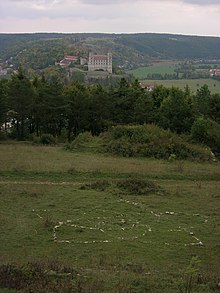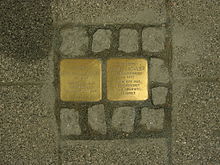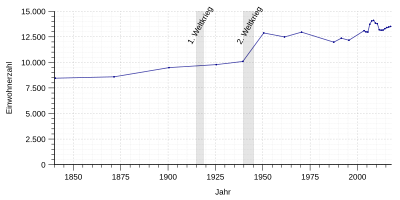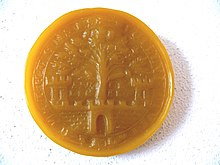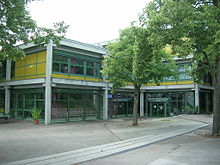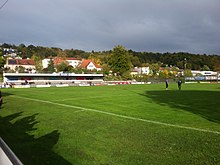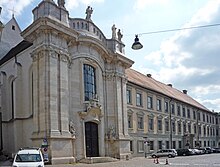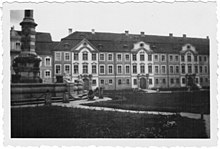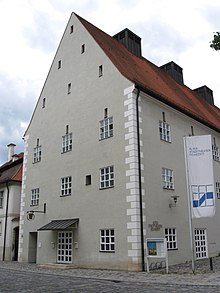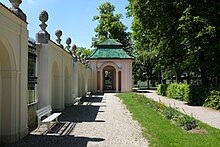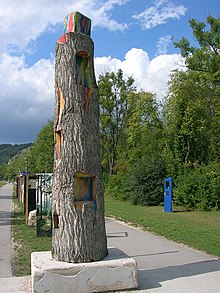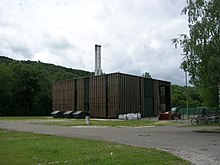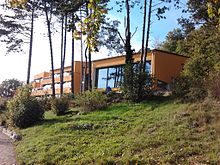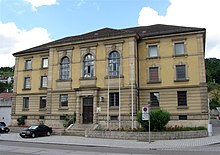Eichstatt
| coat of arms | Germany map | |
|---|---|---|

|
Coordinates: 48 ° 54 ' N , 11 ° 11' E |
|
| Basic data | ||
| State : | Bavaria | |
| Administrative region : | Upper Bavaria | |
| County : | Eichstatt | |
| Height : | 393 m above sea level NHN | |
| Area : | 47.78 km 2 | |
| Residents: | 13,377 (Dec. 31, 2019) | |
| Population density : | 280 inhabitants per km 2 | |
| Postal code : | 85072 | |
| Area code : | 08421 | |
| License plate : | EGG | |
| Community key : | 09 1 76 123 | |
| LOCODE : | DE EIC | |
| City structure: | 14 parts of the community | |
City administration address : |
Marktplatz 11 85072 Eichstätt |
|
| Website : | ||
| Lord Mayor : | Josef Grienberger ( CSU ) | |
| Location of the city of Eichstätt in the Eichstätt district | ||
Eichstätt is a large district town in Upper Bavaria . The city is the seat of the district of the same name and the administration of the Altmühltal Nature Park , as well as the seat of the bishopric of the Eichstätt diocese and the headquarters of the Catholic University of Eichstätt-Ingolstadt .
geography
location
The city is located on the Altmühl , near the geographical center of Bavaria and in the triangle of the largest Bavarian regional centers of Munich , Nuremberg and Augsburg . Neighboring communities are starting clockwise in the north: Pollenfeld , Walting , Adelschlag , Dollnstein and Schernfeld .
City structure
The municipality has 14 officially named municipal parts (the type of settlement is indicated in brackets ):
|
|
In addition to the core city, Eichstätt consists of the historic suburbs Buchtalvorstadt, Ostenvorstadt, Spitalvorstadt / Frauenberg and Westenvorstadt. In the second half of the 20th century the building areas Burgberg, Eichendorffstraße, Herzogfeld, Landershofen-Siedlung, Seidlkreuz, Weinleite (called "Little Jerusalem" due to the flat roof construction) and the industrial area Sollnau (including the production site of the lamp manufacturer Osram ).
Waters

The city is dominated by the Altmühl, which flows through the urban area through the districts of Wasserzell, Rebdorf, Marienstein, Eichstätt, Pietenfeld an der Leithen and Landershofen.
The Kapellenbach also flows through the city . In addition, a canal , known as Buchtalbach , runs mostly underground through pipes through the city. Both waters are exclusively in the area of the main town.
Surveys
The city is considered the capital of the Altmühltal . The northern slope of the valley above the town forms an extension of the Franconian Jura . At 574 meters, the highest point in the city is a former spoil dump near the Lüften district. At the lowest point, at 384 meters, the Altmühl leaves the city. The city center is at an altitude of 393 meters. The city is the eponymous place of the Eichstätter Alb .
history
prehistory
About 150 million years ago, the northern edge of the Jurassic Sea was here with coral reefs and lagoons, on the bottom of which limestone was deposited in layers as plate limestone . Enclosed animal and plant remains were preserved as fossils , including Juravenator and Archeopteryx , some of which were found in Eichstatt quarries. After the end of the Weichsel / Würm glacial period , the middle Altmühltal was created by the Urdonau , also known as the Altmühldonau in this section . Petrified coral reefs were preserved as striking stone formations and still characterize the slopes of the Jura today. The first traces of people in the Eichstätt area date back to around 10,000 BC. Dated.
Early history and antiquity
Already in the Hallstatt period (8th to 6th century BC) and the time of the Celts ( Latène period from 5th century BC) there was a small settlement around the site of the cathedral , which was named Eistedd (probably from the Celtic: place of residence or meeting place). Between 80 and 260 AD, Eichstätt was part of the Raetia province and housed a small Roman settlement ( Villa rustica ), which is believed to be north or north-east of the cathedral. Roman finds were made in the cathedral area, but no Roman remains were found. The Limes ran north of Eichstätt . This was stormed by the Alemanni in the years 213, 233 and 259 and the Romans withdrew across the Danube .
middle Ages
.. 741 or 742 AD Benedictine monk Willibald by Winfried Boniface to Bishop dedicated and after Eichstätt assigned; the "regio Eihstat", the Suidger, a nobleman of the Bavarian duchy, had given to Boniface for his salvation and passed this on to Willibald, was "completely devastated, so that no house was there", with the exception of a Marienkirche. In their vicinity, in the area of today's cathedral, Willibald built a monastery as instructed as the original cell of the diocese of Eichstätt, which was founded before 762. Around 880 the bones of the sister of St. Willibald, St. Walburga , transferred from Heidenheim to Eichstätt; A Benedictine monastery was founded at her grave in 1035 and is still a pilgrimage destination today. This saint is venerated almost all over the world.
In the 8th century, Eichstätt belonged politically to the Nordgau . On February 5, 908 gave King Louis IV. Bishop Erchanbald the market , coin and customs law and the right to Walling; this is now considered by the city itself to be its founding date. “Eihstat” was allowed to call itself “civitas” ( city ) in 1042 . In 1003, the German King Heinrich II put down a rebellion by Heinrich von Schweinfurt . As a result, the Nordgau was dissolved into sub-counties. The areas around Eichstätt came to Count Berengar.
In 1205 the Counts of Grögling-Hirschberg received bailiwick rights. Eichstätt became the royal seat of the county of Hirschberg. Nationally known the doctor and was an important regimes sanitatis composing, writers Conrad of Eichstaett (* 1275, † August 1342), son of Eichstätter city judge Hiltbrand. Konrad, who was enfeoffed with the “Tithe to Piburch” from Bishop Gebhard von Eichstätt in 1327, also ran a bathing room in Eichstätt, which in 1341 was converted into a brewery. From 1305 to the beginning of the 19th century, the bishops of Eichstätt ruled over the city and the bishopric of Eichstätt . From 1500 to 1806, the Hochstift was part of the Frankish Imperial Circle within the Holy Roman Empire of the German Nation .
In the Middle Ages, the area around Eichstätt was also used for wine-growing. Some of the terraces created for this purpose can still be seen today. With the beginning of the Little Ice Age and due to the devastation of the Thirty Years War, viticulture was finally given up.
In the late Middle Ages, Hussite influences were also noticeable in Eichstätt .
Modern times
Early modern age

Witch hunt in Eichstätt
From 1582 to 1723, at least 241 people, 211 women (88%) and 30 men (12%), were charged and arrested in the Eichstätt monastery on suspicion of so-called witchcraft . 222 (195 women, 27 men) of them were demonstrably sentenced to death in witch trials and executed, including Kunigunde Sterzl , Eva Hohenschildin and Helena Schneckin . For the remainder, either the execution has not yet been proven, or they died while in custody or were released. The main phase of the witch hunt in the Eichstätt Monastery lasted from 1617 to 1630 and fell during the reign of Prince-Bishop Johann Christoph von Westerstetten . In these 14 years at least 185 arrests and trials and 167 executions of 141 women and 26 men for witchcraft can be proven, of which between four and 25 (1620) death sentences are continuously passed each year. The last known execution for witchcraft took place in Eichstätt in 1723.
Further developments
Between 1540 and 1546, Eichstätt was hit by an epidemic that killed numerous people. As a result, the east cemetery, which was only built in 1534, was further enlarged. At the instigation of Prince-Bishop Moritz von Hutten , the granary was built on Residenzplatz in 1550. This now houses the Old City Theater. The establishment of the Collegium Willibaldinum as part of the Tridentine reform is dated to 1564 . The Hortus Eystettensis on the Willibaldsburg was built at the instigation of Prince-Bishop Johann Konrad von Gemmingen from 1597, but was devastated again in the Thirty Years War .
At the time of the Thirty Years' War , the city was considered a "stronghold of Catholicism" and faced a momentous attack by the Swedes. They conquered and plundered the city. In 1633 the city and Willibaldsburg were occupied and pillaged several times; The Swedes took numerous cannons, weapons, ammunition and large quantities of flour and grain and brought them to their camp in Neuburg. On February 12, 1634, large parts of today's inner city were almost completely destroyed. 444 houses and six churches fell victim to the devastation; only 127 houses, the cathedral, the parish church of Our Lady, the St. Walburg Monastery , the Dominican Church and the Johanneskirche survived the looting. On September 5th of the same year, however, there was further destruction. Another 44 buildings were set on fire. As a result of the destruction by the Swedes, the cloth making trade in Eichstätt almost completely died out. Reconstruction began in 1639 and continued until the end of the 18th century. It was mainly done by Graubünden and Italian master builders , especially Gabriel de Gabrieli , Jakob Engel and Maurizio Pedetti . In keeping with the era, it was built in the baroque style. The townscape created in this way shapes Eichstätt to this day. The reconstruction was also heavily promoted politically and financially by the prince-bishops, but it was also intended to steer it. For example, a decree by Prince-Bishop Johann Euchar Schenk von Castell from 1685 provided for tax advantages, concessions and free construction timber for “city-like, completely bricked, three-story houses” with a tiled roof (instead of a slate roof ).
According to a tax book from 1696, this year u. a. 15 bakers, eight melbers (flour dealers), 25 butchers, 14 brewers, 22 landlords, 23 shoemakers, eleven red tanners , six white tanners , 13 bricklayers, eight cloth makers, 13 weavers and 17 shopkeepers, including a wholesale merchant.
Eichstätt was largely spared from the War of the Spanish Succession . In 1703 French-Bavarian cuirassiers invaded the city; However, the Franco-Bavarian army was defeated in 1704 in the Battle of Schellenberg and in the Second Battle of Höchstädt by the Great Hague Alliance , which also benefited Eichstätt. On the occasion of this, in 1704 Franz Xaver was declared another city patron alongside Willibald and Walburga; a votive plaque in the Guardian Angel Church reminds of this.
The Imperial Post Office operated by Thurn und Taxis opened a post office in Eichstätt in 1708, which was nationalized in 1808. In 1735 the construction of the summer residence and the court garden began . In 1791 the Eichstätter intelligence sheet appeared for the first time , which was the city's first newspaper.
At the end of the 18th century, the coalition wars also made themselves felt in Eichstätt. So it came several times to marches and looting; in 1800 the Rebdorf monastery was sacked by General Dominique Joba . From 1795 Eichstätt was the main field hospital of the Imperial Army .
19th century
With the secularization of 1802/03, Eichstätt became part of the Electorate of Salzburg . The Peace of Pressburg in 1805, in turn, meant that the electorate came under Elector Ferdinand to the Austrian Empire . The city of Eichstätt fell to the Kingdom of Bavaria in December 1805 . In 1806, at the instigation of the police commissioner, Eichstätt was divided into eight districts marked with letters: A. Residenzviertel, B. Marktviertel, C. Rossmarktviertel, D. Walburgisviertel, E. Buchtalvorstadt, F. Ostenvorstadt, G. Spitalvorstadt and H. Westenvorstadt. This division was in place until 1957.
From 1817 to 1833 Eichstätt was the capital of the Bavarian media rule of the Principality of Eichstätt , which the Dukes of Leuchtenberg held.
A connection of Eichstatt to the rail network was not originally planned. It was only after long efforts by the city tour and the citizens of Eichstätt that Eichstätt was finally connected to the rail network in 1870 by the Treuchtlingen-Ingolstadt railway line and was given its own train station a little outside the city. In this context, several service and residential buildings were originally built for the construction work; this finally developed into today's district of Eichstätt-Bahnhof. A direct connection to the city was achieved in 1885 by building a narrow-gauge line from Eichstätt station to the vicinity of the city center and the city station; this route was converted to standard gauge in 1934.
The construction of the gas supply began in 1863. For this was the Cobenzl castle one with coal -powered gas works built, which was first intended for the supply of street lighting. Later it was also used to supply households. The Eichstätter fire brigade was also founded in 1863.
In the 19th century, Eichstätt lost its own jurisdiction to Ingolstadt . The ecclesiastical jurisdiction, the official office , however, still exists today. Around 1900, a separate penal institution with a historical head building was built on the site, directly opposite the lower train station , which has been used continuously since then with extensions.
The city's central water supply was completed in 1889; on September 27, 1920 the connection to the power grid followed.
20th century
The consequences of the November Revolution of 1919 also affected Eichstätt. The Freikorps Oberland was founded in Ingolstadt and Eichstätt . Ernst Toller was imprisoned in the temporary fortress prison of Eichstätt for a few months after his conviction. A workers 'and soldiers' council was also formed in Eichstätt . On December 15, 1918, the municipal council decided to set up a vigilante group; however, implementation of this decision took a few more months.
In the city council elections on June 15, 1919, after the introduction of women's suffrage in Germany the previous year, Maria Buchberger ( Bavarian People's Party ) was the first woman to be elected to the Eichstätter city council.
There has been a police barracks since 1926, which houses today's 2nd Riot Police Department (II. BPA) with training seminars.
At the end of the 19th century and in the first half of the 20th century, Eichstätt fell more and more behind due to its remote location. There was hardly any economic development, the city remained primarily an administrative and school center. This led to major economic problems and high unemployment; in the winter of 1932/33 1,800 people were registered as unemployed. Due to the low tax income due to the scarce industry, Eichstätt also accumulated large debts; As of March 31, 1933, the debt was 1,181,252 Reichsmarks .
time of the nationalsocialism
The NSDAP , which founded a local group as early as 1922, initially found it difficult to establish itself in Eichstätt. For a long time, the Bavarian People's Party played the dominant role in the city . In the elections between 1930 and 1933, the NSDAP had the weakest results in all Central Franconian administrative districts and even after the so-called seizure of power in the Reichstag elections on March 5, 1933 , the Bavarian People's Party only won 2,493 votes. This was partly due to the remoteness the city, v. a. but also in the strong position of the Catholic Church, which the National Socialists were initially unable to break through. The state ordinances and emergency ordinances such as the ban on uniforms and the possibility of banning assemblies were also consistently enforced in Eichstätt, which made it significantly more difficult for the NSDAP to carry out its usual propaganda appearances.
Nevertheless, in 1933 the National Socialists quickly managed to gain control of the city. Already on March 9th, a swastika flag was hoisted by the SA in the town hall with the tolerance of the city administration . On the following day four leading persons of the Reichsbanner Schwarz-Rot-Gold or the Iron Front and the KPD were taken into protective custody, later also other members of the KPD and the SPD as well as the Bayernwacht . The National Socialists thus quickly succeeded in creating a climate of fear in Eichstätt. The top administration was replaced by officials and politicians who were loyal to the line. The BVP mayor Otto Betz was left in office until the end of May 1934 and was only then replaced by the NSDAP district leader Walter Krauss . In the course of the Gleichschaltung , the city and district councils were newly formed on the basis of the election results of March 1933, which on paper led to a BVP majority, but practically strengthened the position of the NSDAP. In the course of the following weeks, the seats of the SPD and BVP were withdrawn one after the other, which gave the NSDAP sole control over both bodies until the end of July. In addition, the National Socialists demonstrated their power to the church by temporarily taking three clergy into protective custody.
Finally, the associations, guilds and the associations often under church management followed, which, however, proved to be difficult due to a lack of staff and the continued strong roots of the church in the population as well as the strongly developed church youth work. The Hitler Youth was initially difficult to gain a foothold in Eichstaett. Catholic youth associations also played an important role in this, but some of them, like the Sturmschar , increasingly politicized and militarized themselves, often combined with increasing advertising for the BVP in the course of the March elections in 1933. The youth work in Eichstätt also played an important role active priest Ingbert Naab , who campaigned against National Socialism and for a Germany shaped by Christianity.
The initially strong position of the Catholic associations was quickly offset by a large number of people, especially from the civil servants, to the National Socialist organizations due to public pressure or for reasons of opportunity . The change of course by the German bishops also contributed to this: if they had previously opposed the National Socialist movement, this changed quickly after the so-called seizure of power. Ultimately, the Eichstätter was Bishop Konrad Graf von Preysing , the only Catholic diocese leader in Germany, which is against the 1933 by the Holy See and the Reich government agreed Reichskonkordat turned. The leadership of the Catholic associations such as the Catholic Journeyman Association , the German Kolping Family , the Catholic Burschenverein or the Catholic Young Men Association finally switched to the new state line themselves or at least partially took over it. This led to broad resistance at the grassroots level, which meant that the Catholic youth organizations in Eichstätt in particular remained a place of resistance against National Socialism beyond 1933, even if their position continued to weaken.
Adolf Hitler visited the city several times and was often a guest in the Waldschlösschen restaurant. In December 1933 he was granted honorary citizenship of the city.
In 1935 the Eichstätter Thingstätte was built by the National Socialists on the Geisberg in the then still independent municipality of Wintershof. Gauleiter Julius Streicher was present at the inauguration ceremony on July 6, 1935 . However, it was not completed until 1937. Today, the Thingstätte is dilapidated and overgrown.
Between 1939 and 1945, the Oflag VII B prisoner of war camp was located in the east suburb of Eichstätt . In addition, the Willibaldsburg in Eichstätt was from October 1944 to January 1945 the location of a satellite camp of the Flossenbürg concentration camp ; 22 prisoners were housed there. There were no fatalities in Eichstätt.
The city lost its district freedom in 1940.
In the urban area of Eichstätt, in contrast to the surrounding communities and cities, there was no significant war damage from Allied attacks. After fighting since April 23, the city was occupied by US troops on April 25, 1945. On April 24th, two men were hanged by SS men on Leonrodplatz because they had tried to prevent the hospital bridge from being blown up. The bridge was finally blown up on the night of April 25th, but this was not a major obstacle for the US troops. That same night u. a. the NSDAP mayor Hans Rösch, other politicians, some soldiers and Gestapo officials the city. Chief Inspector Josef Kleber took over the official business . Although the fighting continued on April 25th, at the instigation of some people such as the abbess of the St. Walburg monastery, Maria Anna Benedicta von Spiegel , the official officer in the town hall, Anton Halbich, and Colonel Otto Marschall , the city was finally able to pass peacefully to the US Armed forces are handed over. The US troops then advanced further east and the next day liberated other places in the area such as Pfünz , Inching , Pietenfeld , Hofstetten , Eitensheim , Hitzhofen , Lippertshofen , Friedrichshofen and Kipfenberg . Josef Kleber was briefly appointed mayor by the US military government, but due to his Nazi functions he was removed, arrested and sentenced. He was replaced by Romuald Blei on May 9th .
After the Second World War
In 1949 the city became a district again. With the Bavarian regional reform in 1972, Eichstätt, which had belonged to the Central Franconia administrative region since 1838 , moved to Upper Bavaria . In the process, the city again lost its status as an independent city.
The gasworks at Cobenzlschlösschen last operated by the municipal utilities were closed in 1964. The construction of the Seidlkreuz building area began in 1966. The outdoor pool opened in 1970.
The Altmühltal Nature Park was founded in 1969 . In the same year, the Eichstätter city police became part of the Bavarian police .
In 1980, the former was Polytechnic Eichstaett Eichstaett applicable to Catholic University. Due to the establishment of the economics faculty in Ingolstadt in 1989, the KU was renamed the Catholic University of Eichstätt-Ingolstadt in 2001 .
The old city theater was inaugurated in 1988; the following year, the Altmühltal Nature Park information center was set up . In 1992 Eichstätt received its city line.
21st century
The new construction of the outdoor pool, which began in 2006, was completed in 2010. Since 2011, the new Spitalstadt district has been built between the station grounds and Altmühl. It will provide space for service and retail companies, administrative facilities, apartments, a hotel and a new bus station . The first buildings were completed in 2014, the new bus station in 2015. By 2020 a four-star conference hotel was built.
In 2014 Eichstätt was awarded the title of Fair Trade City . Since May 2015 there have been seven stumbling blocks by the artist Gunter Demnig in the Eichstätter city area in memory of the victims of National Socialism.
Between 2014 and 2017, the former premises of the Maria Ward Realschule were used as a branch of the refugee reception center in Munich . In June 2017 the central deportation detention center in Bavaria was opened in the former penal institution .
In early 2019, the city hit the headlines nationwide when it was sued by a law student who found the signs for the women's parking spaces at the open water parking lot to be discriminatory. The city then announced that it would change the signage to better emphasize the non-mandatory recommendation character. The signs were put up in 2016 after a woman was raped not far from the parking lot.
In 2019, a town partnership was signed with the French community of Montbrison .
At the beginning of March 2020, the Chinese owner MLS announced that it would close the Ledvance plant in Eichstätt with its approx. 360 employees. A little later, Osram also announced that it wanted to close its plant.
During the COVID-19 pandemic , a provisional central test station for the entire district was set up in Eichstätt from the end of March 2020.
Incorporations
On July 1, 1972, the previously independent municipalities Landershofen and Wasserzell were incorporated. Marienstein was added on January 1, 1974. Buchenhüll and Wintershof as well as small areas of the dissolved municipality of Pietenfeld, with the small hamlet of Pietenfeld an der Leithen , followed on May 1, 1978.
Population development
Between 1988 and 2018, the city grew from 12,118 to 13,525 by 1,407 inhabitants or 11.6%.
|
|
|
politics
City council
The city council election of March 15, 2020 resulted in the following distribution of the 24 seats:
| Political party | percent | Seats | G / V |
|---|---|---|---|
| CSU | 38.13% | 9 | ± 0 |
| SPD | 19.57% | 5 | ± 0 |
| GREEN | 16.63% | 4th | + 1 |
| FW | 13.68% | 3 | - 2nd |
| ödp | 7.49% | 2 | ± 0 |
| BP | 2.71% | 1 | + 1 |
Mayor and Lord Mayor
Josef Grienberger ( CSU ) was elected Lord Mayor with 62.17% in the runoff election on March 29, 2020 . His challenger was Christian Alberterer ( SPD ).
|
|
Town twinning
-
 Vestenanova (Italy)
Vestenanova (Italy) -
 Kratzau / Chrastava (Czech Republic)
Kratzau / Chrastava (Czech Republic) -
 Montbrison (France)
Montbrison (France)
Other partnerships
-
 Pune (India) (partner diocese)
Pune (India) (partner diocese)
Sponsorship
-
 In 1953, the city of Eichstätt sponsored the expelled Sudeten Germans from the city of Kratzau in the Reichenberg district in the Sudetenland .
In 1953, the city of Eichstätt sponsored the expelled Sudeten Germans from the city of Kratzau in the Reichenberg district in the Sudetenland .
Coat of arms, seal and flag
Blazon : "In red from green bow sign foot growing a continuous schwarzgefugte silver walls with central open stone combined gate, flanked by two crenellated silver churn towers, behind a stylized symmetric green oak tree with two bifurcated branches, five leaves and six golden acorns."
The modern coat of arms became the official city coat of arms between 1808 and 1810; in 1819 the color scheme was adapted to the current version. This coat of arms has its origin in the seal of the city. This is mentioned as early as 1256. The oldest surviving seal is on a document from 1304 and already shows the coat of arms above.
The first mention of Eichstätts - in the form "Eihstat" - dates back to 740 in connection with the foundation of the diocese. In 908 King Ludwig IV granted the child Bishop Erchanbald market, coin and customs rights as well as the right to build a castle. On coins of Bishop Heribert (1022-1042) the name city (civitas) can be found for the first time; later also in a document from King Henry IV from 1080. The coat of arms refers to this elevation of the city through the depiction of the city wall. The name "Eichstätt" was interpreted as an "oak site"; as a result, an oak was added to the coat of arms. This coat of arms is a so-called " talking coat of arms " that explains the name of the place.
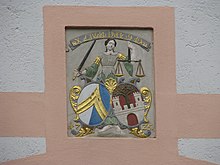
Eichstatt's coat of arms, used before the 19th century, looked completely different. It was a shield, mostly split in blue and silver, with a golden rafter . This coat of arms is documented in the coat of arms books from 1486 to the 19th century and can also be found in the city, for example above the balcony door of the town hall.
The city's flag is red and white and has been in use since the 19th century.
Education and culture
University and schools
The Catholic University of Eichstätt-Ingolstadt has its headquarters in Eichstätt . There are also numerous schools here, such as the musical Gabrieli high school , the linguistic and scientific-technical Willibald high school , the Eichstätt-Schottenau middle school , the Eichstätt Montessori school with primary and secondary levels, the Maria Ward girls ' secondary school and the boys' secondary school Rebdorf in the diocese of Eichstätt, the primary schools Am Graben and St. Walburg, the state vocational school, the Eichstätt support center, the FOS / BOS and the specialist academy for social education.
Cultural events and associations
Associations that regularly offer public educational measures are the adult education center , the Katholisches Bildungswerk in the district of Eichstätt, the KEB diocesan educational institute Eichstätt, the educational institute of the Catholic women's association , the Kolping educational institute / adult education institute in Eichstätt, the Altmühltal Citizens Network Association (AltmuehlNet), the music school Eichstätt and the music network Eichstätt.
The lithography workshop of the city of Eichstätt is of national importance. International artists regularly spend time here and in Solnhofen , the region in which the invention of lithography was only possible thanks to the mining of Solnhofen limestone .
Libraries and Archives
- Library of the city of Eichstätt and the Sankt Michaelsbund
- Eichstätt-Ingolstadt University Library of the Catholic University (with the central library and three other sub-libraries)
- Eichstätt diocesan archive
- Eichstätt City Archives (in the town hall)
- Media center of the district of Eichstätt
- Media center of the diocese of Eichstätt
Museums
- Jura Museum in Willibaldsburg (including a fossil Archeopteryx from Solnhofen )
- Bergér Museum in the Harthof near Eichstätt
- Museum of Prehistory and Early History on the Willibaldsburg (regional history from the Stone Age to the Early Middle Ages)
- Altmühltal Nature Park Information Center
- Diocesan museum with cathedral treasure
- Railway open-air museum at the Eichstätt Stadt stop
Events
Well over 500 public events of all kinds take place in Eichstätt every year. B. the Walburgi-Dult, the folk festival, concerts of the Eichstätter Stadtkapelle, Jura Massive, events on the cabaret "Im Gutmann", the cathedral concerts, events of the Eichstätter cathedral choir, organ music at noon, Eichstätter seminar concerts, organ concerts in the Erlöserkirche, events of the Eichstätter Chamber Orchestra, Schola Gregoriana in the cathedral, events of the brass ensemble Stahlblosn , the music festival Open Air am Berg , the folk music day in the middle , the music festival Eichstätt (for early music ), the aviator festival , markets, events of the university etc. Between 2013 and 2017 there were In addition, annual language schools run by the student refugee initiative do.
Sports
sports clubs
There are numerous sports clubs. The most famous is the VfB Eichstätt with its football division, which after the championship in the Bayern League North in 2017 since the season 2017/18 in the Regionalliga Bayern plays. The club is based in the Liqui-Moly Stadium, which holds 2090 spectators. Measured by the number of members of over 1200 (as of March 2018), it is the second largest association in the city.
In terms of the number of members, the largest association in the city is the Eichstätt section of the German Alpine Club . This operates the DAV - climbing center Eichstaett "Jura Bloc" in the shearing field and Glorer hut in the Hohe Tauern . There is also the DJK Eichstätt, the Eichstätt boxing club, the Rot-Weiß Eichstätt tennis club, the Türk Gücü Eichstätt FC sports club, the Eichstätt flying club, the Eichstätt police sports club, the Marienstein sports club, the Eichstätt chess club , the Eichstätter dance club, the Kgl. Priv. Eichstätt fire rifle club, the Rebdorf Marienstein rifle club, the Wasserzell sports club and the Eichstätt vaulting club . In addition, the Catholic University and the Adult Education Center also offer a diverse sports program. The JFG Region Eichstätt also formerly existed , but was dissolved in 2018.
Sports infrastructure
The sports infrastructure includes the DJK sports hall with bowling alleys, the Liqui-Moly stadium, the artificial turf pitch of VfB Eichstätt and other facilities of this club, the Eichstätter airfield, various school sports facilities and halls, the university's sports facilities, in particular the Seidlkreuz university sports facility, which Boxer hall, outdoor and indoor swimming pool, the tennis facilities of the TC Eichstätt, the sports facilities of the riot police, the sports facilities of the Maria Ward complex, a skate facility, an ice rink, a health park, a golf practice area, a riding facility, a cross-country ski run and smaller sports fields in the individual districts . Not far from the city limits, but already in the municipality of Schernfeld, there is further important sports infrastructure with a mini golf course and the sports facilities of the DAV, such as the climbing center and the mountain bike facility.
Others
The village was several times on the respective route of the Bayern Tour and was a stage in 2007.
Religions
Catholic churches
- Cathedral with mortuarium
- Guardian Angel Church (former Jesuit Church)
- Parish Church of the Holy Family
- Parish Church of St. Johannes Baptist (Rebdorf; former Rebdorfer monastery church )
- Maria Hilf Chapel (Westenstrasse)
- Marienkapelle on the Frauenberg
- Heilig-Geist-Spitalkirche
- Maria Schnee cemetery chapel , rebuilt in 1711 at the Ostenfriedhof
- Fourteen Holy Helpers in Wasserzell
- Church of the Holy Cross in Wintershof
- St. Benedikt Landershofen
- Pilgrimage Church of the Assumption of Mary (Buchenhüll)
- Former Dominican Church of St. Peter and Paul (sacred reuse since December 2007)
Monasteries and ecclesiastical training centers
Existing monasteries or monastic communities
- St. Walburg Monastery and Parish Church ( Benedictine Sisters )
- The Passionists' Holy Cross Eichstätt (in the former Capuchin monastery with the former Capuchin Church of the Holy Cross and a Holy Grave )
- Rebdorf Monastery of the Missionaries of the Sacred Heart of Jesus, called: Herz-Jesu-Missionare
- Convent of the Missionaries of Christ in the Rebdorf district
- Salesianum Rosental - Monastery of the Oblates of St. Francis de Sales
- Congregatio Jesu , formerly the Institute of the English Misses
- Franciscan Sisters of Maria Stern in Eichstätt-Marienstein, children's village
- Sisters of the Divine Redeemer = Niederbronn sisters in the Caritas nursing home St. Elisabeth
- Sisters of the Sorrowful Mother in the "House of Encounter", Notre-Dame-Weg 2
- Secular institute of the Schoenstatt Sisters of Mary in the children's home of the cathedral parish
Former monasteries
- Dominican Monastery and Dominican Church of St. Peter
- Convent and monastery church of Notre Dame du Sacré Cœur
- Augustinian Choir Women Monastery Marienstein in the Marienstein district
- Holy Spirit Convention
- Augustinian Canons Rebdorf Monastery
- Collegium Willibaldinum , Jesuit College Eichstätt
- Brother House St. Sebastian in the Spitalvorstadt
- Schottenkloster (today Capuchin Monastery)
Secular priestly training centers
- Collegium Willibaldinum , the episcopal seminary of the diocese of Eichstätt
- Collegium Orientale , a preparatory college that is open to members of the Eastern Catholic Churches, the Byzantine Orthodox and the Oriental Orthodox churches, united with Rome. The students are accommodated in the building of the former "small seminar" of the Eichstätt seminary; there is the "Heilig Geist Kapelle", a neo-Byzantine chapel from 1998.
Other religious communities
- Evangelical Lutheran Parish Church ( Erlöserkirche ) at the transition from Leonrodplatz to Residenzplatz
- Islamic prayer room on Weißenburger Strasse
- Kingdom Hall of Jehovah's Witnesses in the industrial park of the Wintershof district
- Former Jewish prayer room in a town house on Pfahlstrasse
- Former New Apostolic Church in Marienstein
Attractions
Castles and Palaces
- Willibaldsburg
- Former prince-bishop's residence (The Residenzplatz is a baroque ensemble of buildings that has rarely been preserved.)
- Former summer residence of the prince-bishop (today the administration building of the Catholic University)
Places
Residenzplatz
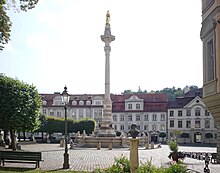
The Residenzplatz was created in the 18th century by the prince-bishop's master builder Gabriel de Gabrieli . Maurizio Pedetti took over from 1776 to 1780 the further development and expanded the space around the fountain with Marian column , which pflasterstrahlige Place parquet floors and a curved Linde Half Rondell as a conclusion to the east.
In 1820 the square was redesigned into an English garden at the instigation of Eugène de Beauharnais . In the 20th century, the Bavarian State Monument Preservation recommended that the square be restored to its original state. After this was first rejected by the city council in 1970, it was later decided to implement this proposal. On October 25, 1985, the redesigned square was finally inaugurated.
The headquarters of various public institutions in historical buildings such as u. a. the district office and other authorities as well as Caritas .
Marketplace
The town hall, the Willibaldsbrunnen , the remains of the Collegiata parish church and the medieval building ensemble Paradeis are located on the market square .
Leonrodplatz
The Guardian Angel Church and a baroque ensemble (including the Collegium Willibaldinum ) are located on Leonrodplatz . The square was laid out under the name Jesuitenplatz at the beginning of the 17th century under Prince Bishop Johann Christoph von Westerstetten as a forecourt of the newly built Jesuit College in Eichstätt and the predecessor building of the Guardian Angel Church, which was built at the same time. In 1998 the square was redesigned.
Cathedral Square
The Domplatz is located in the immediate vicinity of the cathedral, the Dom-Augusta-Haus and the former Johannis Church.
Pater-Philipp-Jenningen-Platz
The Episcopal Palace and the Ulmer Hof , which today houses the Theological Faculty and the Faculty of Religious Education and Church Educational Work, as well as the branch library 1 of the Catholic University of Eichstätt-Ingolstadt, are located at this place .
Kardinal-Preysing-Platz
The Kardinal-Preysing-Platz is adjacent to the former riding school, which today houses lecture halls and the branch library 2 auditorium of the Catholic University of Eichstätt-Ingolstadt. In addition, the building of the Catholic University Congregation (KHG-Zentrum) is located at this place.
Fairground
The fairground is located in the Schottenau area and is used as a public car park for most of the year. However, it also serves as a location for various events, such as a. for the eponymous folk festival and the flea markets; it is also used by the fire brigade for exercise and training purposes. To the west, the Schottenau bus station borders directly on the Volksfestplatz; there is also another bus stop on the east side of the square. The course is designated as a park-and-ride system.
The Schottenau biomass heating plant is located on the Volksfestplatz .
Franz-Xaver-Platz
The Franz-Xaver -Platz could be recreated in the course of the redesign of the core city. This used to belong to the station area and was used to handle heavy and bulk goods, for example imported coal or local quarry products. Today there are retail and service companies as well as apartments.
Bahnhofplatz
Also in the course of the redesign of the core city, the area in front of the station building, which was previously used as an improvised bus station, was redesigned.
Historic Buildings
Eichstätt, which remained almost intact during the Second World War, has a large number of historical buildings, in addition to a castle, residence, churches, monasteries and canons' courts and the like. a .:
- Bischöfliches Palais (opposite the "Ulmer Hof")
- Ulmer Hof , Kanonikerhof, then Willibald-Gymnasium, today a branch library of the university
- Jesuit grammar school, later the house of the Catholic casino, today one of the administration buildings of the Eichstätt diocese
- Episcopal Ordinariate (opposite the Guardian Angel Church)
- Collegium Willibaldinum , formerly a Jesuit college, today a seminary
- Town hall (in front of the Willibaldsbrunnen)
- Medieval residential buildings next to the town hall (today partly a café) from the 13th century
- Orangery (today IT center of the university)
- Old orphanage (today the university's journalists' building)
- Gabrieli House (today residential and commercial building)
- Cobenzlschlösschen with garden pavilion (1864–1964 gasworks; today, among other things, used communally); named after Ludwig Graf Cobenzl
- Linding mill in the west suburb (today the house of KDSt.V. Alcimonia Eichstätt)
- City wall with towers (cannot be walked on / climbed)
- Old city theater (completely redesigned after gutting as a city event venue and cinema)
- Siechhof (privately owned)
- Former "Johanniskirche" , today "Haus des Gastes" (municipal exhibition room)
- Notre Dame du Sacré Cœur , former monastery and monastery church, today the seat of the Altmühltal Nature Park information center and exhibition room.
- Catholic journeyman's house (Kolping House)
- Parts of the Gothic collegiate or parish church of Our Lady on the market square, which was demolished in 1818 (formerly Volksbank; today university use)
- Grain box of the medieval brother house St. Sebastian (today residential house)
- Former royal bay. Penitentiary (today penal institution)
- Jura houses : throughout the city, and especially in the historical suburbs, there are numerous examples of this regional type of house with its compact shape, the flat roof pitch and the characteristic limestone roof . Buildings with steeper roof slopes are also often covered with pinch pockets .
Parks and gardens
There are several parks and gardens in the urban area. The court garden at the summer residence was built from 1735 onwards with originally completely baroque furnishings. In the 19th century, parts of the complex were converted into an English garden .
On the Willibaldsburg is the bastion garden , which was newly laid out until 1998 and provides information about the flora of the Renaissance garden described in the botanical masterpiece " Hortus Eystettensis " by Basilius Besler .
There is also a small park with a fountain and water feature on the street Am Graben. It is traversed by the Buchtalbach, which is enclosed in pipes.
Another small park is located on the Cobenzlschlösschen in Ingolstädter Straße.
graveyards
The cemetery still in use today is the Ostenfriedhof, which is located in the Ostenvorstadt. The west cemetery in the Westenstrasse, which also houses the St. Michael cemetery chapel, is no longer used .
Since Eichstätt is the seat or at least a branch of some religious orders, these also have individual cemeteries in the city of Eichstätt. The main cemetery of the Bavaria region of the Oblates of St. Franz von Sales is located in the south-east of the Salesianum Rosental. Further order cemeteries are z. B. at the Abbey of St. Walburg, at Rebdorf Abbey or - not re-used for a long time - at the former Capuchin monastery.
Modern art and architecture
- Several buildings by the diocesan master builder Karljosef Schattner (including the parish church of the Holy Family on Kipfenberger Strasse or the redesign of the Ulmer Hof ) and Karl Frey (including the Aula am Graben, Salesianum)
- Figure field in the Hessental
- Memorial for victims of witch persecution at the executioner's chapel on the high court on the former Galgenberg
- Gallery of the Kipfenberger painter Carl Otto Müller ("Cézanne des Altmühltales") in the district office
- Stone sculptures "cycle of creation" on the seminar meadow
- Sculptures from the "Open HeArt 2010" art campaign preserved in the city center
Economy and Infrastructure
In the economic field, Eichstätt is best known for its natural stone industry . The Solnhofen slabs (known for lithography ) and Jura marble are extracted in the quarries in the area . The Blumenberg near Eichstätt is where one of the most famous fossils in the world was found: the so-called Berlin specimen of the ancient bird Archeopteryx . With an unemployment rate of 1.2% (as of December 2017), Eichstätt is the city with the lowest unemployment in the Federal Republic of Germany. There is full employment .
traffic
Street
The federal highway 13 , which leads from Würzburg via Ansbach and the Franconian Lake District to Munich , runs in a west-east direction through the urban area of Eichstätt. This federal highway connects the university town to the nearby city of Ingolstadt and thus also to the motorway network. The access from Eichstätt to the federal motorway 9 in the direction of Munich is either via the Lenting or Ingolstadt-Nord junction . In addition, Eichstätt is also connected to the Federal Motorway 6 via the B 13 and the Ansbach junction . Via the Jura-Hochstraße you can get from Eichstätt to Kinding in the Altmühltal and thus have a connection to the German trunk road network to the north, i.e. towards Nuremberg . In addition, the Jura-Hochstraße connects the eastern district of Eichstätt with the district town. The state road towards Titting and Thalmässing connects the episcopal city with the north-western district and beyond with Nuremberg. There is also a connection to the south via the nearby Pietenfeld exit on the B 13, i.e. towards the neighboring district of Neuburg an der Donau . From there it is possible to drive to Regensburg or to Donauwörth and also to Ulm via federal highway 16 . From Neuburg, Eichstätt is also connected to Augsburg and the Swabian-Bavarian foothills of the Alps . From Eichstätt you can also take county and state roads to the places Kipfenberg (from the east of Eichstätt), Dollnstein (from the west of Eichstätt) and Solnhofen .
The Altmühltal cycle path leads from Obereichstätt through Eichstätt and from there on to Pfünz .
Lanes
- Main line Ingolstadt – Eichstätt Bahnhof – Treuchtlingen (KBS 990): every hour to Munich and Treuchtlingen / Nuremberg, in rush hour also every half hour to Ingolstadt
- Branch line Eichstätt Bahnhof – Eichstätt Stadt (KBS 991): feeder trips to the main line Ingolstadt – Treuchtlingen
The Eichstätt Bahnhof station is about six kilometers outside the city. The Eichstätt Stadt stop, which is close to the center, is right next to the central bus station. In December 2018, the Eichstätt Stadt station was modernized and put into operation without barriers.
A small open-air museum was opened at the Eichstätt Stadt stop in 2018. There are u. a. a Köf of the type Gmeinder Köf II , a loading crane and a splinter bunker from the Second World War on display. The exhibition is intended to commemorate the Eichstätt Stadt – Beilngries section that was operated until 1960.
A new use is currently being sought for the old building at the Stadtbahnhof. The citizens' initiative Bahnhof Lives was founded for this purpose .
Public transport
Urban local transport has been handled by its own city bus network since 1992. The operator of the city line is the locally based company Jägle Verkehrsbetriebe GmbH (JVB) and Stadtwerke Eichstätt . The Eichstätt city line serves the entire city area on four main lines and one additional line every half hour and, with around 600,000 passengers per year, is one of the most successful city transports in a small town in Germany. In addition to the Eichstätt city line, there is also a long-distance bus to Ingolstadt. Above all, university students and workers and employees from Ingolstadt companies use this offer.
Various local transport companies from the region have joined forces in the Altmühltal transport association .
The city has a share in the community tariff of the Ingolstadt planning region that has existed since September 2018 .
air traffic
One kilometer south of the city center there is Eichstätt airport with a 715 meter long taxiway and its own gas station. However, this has so far only been partially paved in several unconnected 100-meter pieces. This severely restricts the load-bearing capacity on machines under 2 or 5 tons in flight weight. It is therefore only used occasionally by some recreational pilots , the Eichstätt Aviation Club and the Bavarian Air Rescue Unit. Regular passenger transport or freight handling does not take place there.
power supply
The power supply is ensured by the Eichstätt municipal utility. As of December 31, 2014, these have a 188-kilometer underground cable network with 61 transformer stations. Every year around 84 million kWh of electricity flow through this network and over 3900 house connections are supplied with it. Until 1964, the city's gas supply was guaranteed by the gas works at Cobenzlschlösschen. However, due to the sharp increase in consumption, the city decided to connect to the long-distance natural gas supply. The municipal gas network will continue to be operated by the municipal utilities. 180 million kWh of natural gas are supplied to 3,300 household connections via the 60-kilometer pipeline network (as of December 31, 2014).
Stadtwerke operates two heating plants for district heating: the Schottenau biomass heating plant opened in 2010 and the Spitalstadt combined heat and power plant opened in 2013 . It supplies properties in the district (school center, Eichstätt clinic), the Catholic University, the church and the Bavarian riot police (Schottenau biomass heating plant) as well as properties in the area of Weißenburger Strasse and the Spitalstadt development area (Spitalstadt combined heat and power plant).
Water supply and sanitation
The municipal utilities are responsible for the water supply and waste water disposal.
A modern drinking water supply has existed since 1888; previously the residents had to draw the water by hand from up to 30 wells spread across the city. Originally, the water supply was provided via the water meadow in the area of Westenstrasse. In the course of the 20th century, more wells and water tanks were added. The newly built Pfünzer Forst waterworks has been used to supply the city with water since 2000 . In 2014 the water discharge was 720,600 m³; the total annual output is around 1.2 million m³.
The wastewater is mainly about 1970 commissioned in the central treatment plant ensured; the Buchenhüll district has its own sewage treatment plant. Since the expansion, which was completed in 2006, the water has been clarified in three purification stages. Around 800,000 m³ of wastewater are disposed of annually via the 92-kilometer sewage disposal network (as of 2014).
Aid organizations
There are several aid organizations in the city . The Bavarian Red Cross is represented by a district association in Eichstätt. The Malteser Hilfsdienst helps the BRK and also looks after the dying and relatives of the severely disabled in an outpatient hospice care facility . In addition to the two rescue services, there is also the volunteer fire brigade of the large district town of Eichstätt. There is also the Technical Relief Organization , which is represented by a local association in Eichstätt. There is also a Caritas association for the diocese of Eichstätt . The Dollnstein mountain rescue service is also responsible for Eichstätt. The Eichstätt district water watch has its seat in Eichstätt; there is also a local group.
health care
The following departments are represented in the town:
- Geriatric traumatology
- Internal medicine :
-
surgery
- General and visceral surgery
- Orthopedics and trauma surgery
- Pediatric orthopedics and neuro- orthopedics
- Obstetrics and gynecology
- Anesthesia and intensive care medicine
There are also numerous private medical practices in various fields.
media
The city is a publishing place . The daily newspaper Eichstätter Kurier has been published here since 1864 , today a head page of the Ingolstädter Donaukurier , and as a city magazine among other things the Eichstätter Journal des proEichstätt e. V. There is also the free Eichstätter Anzeiger advertising paper , which is part of the IZ-Regional association .
Other publishers include Siegfried Sporer jun. And Eichstätter Verlag. There are also institutions similar to publishers, e.g. B. the university's own publishing house or the Jura-Verlag Eichstätt / Dollnstein .
In Eichstätt the church newspaper for the diocese of Eichstätt is produced by Willibaldsverlag .
The Franz-von-Sales-Verlag , which was largely influenced by the Congregation of the Oblates of St. Franz von Sales (short: OSFS ) is carried and financed. For many years he has published the magazine Licht , a magazine for Salesian spirituality.
Radio and television
The student radio Radio Pegasus offers information about Eichstätts University on Mondays at 7 p.m. on the frequency of the Ingolstadt radio station Radio Galaxy .
The church radio production facility radio k 1 is located in Eichstätt and broadcasts its programs on the radio IN frequencies every week.
There is no direct local television station, but the nearby Ingolstadt television station intv - the information channel about Eichstätt - also reports .
Wintershof transmitter
The following frequencies are broadcast from a Deutsche Telekom filling station ( 48 ° 54 ′ 10.9 ″ N , 11 ° 9 ′ 45.3 ″ E ) in the Wintershof district of Eichstätt:
|
Frequency (in MHz) |
program | RDS PS | RDS PI | Regionalization |
ERP (in kW) |
Antenna pattern round (ND) / directional (D) |
Polarization horizontal (H) / vertical (V) |
|---|---|---|---|---|---|---|---|
| 99.1 | Radio IN | RADIO_IN | D71B | Eichstatt | 0.1 | ND | H |
| 106.6 | Antenna Bavaria | _ANTENNA_ | D318 | - | 0.5 | ND | H |
Bayerischer Rundfunk operates its own small filling station below the Wintershof station. It is also known internationally as "Sender Eichstätt / Schönblick" because of the nearby panoramic view of Eichstätt and a neighboring restaurant / hotel of the same name. ( 48 ° 54 ′ 4 ″ N , 11 ° 9 ′ 40.5 ″ E ): It broadcasts the following stations in an internationally coordinated manner, of which only one frequency has so far been activated (in bold).
|
Frequency (in MHz) |
program | RDS PS | RDS PI | Regionalization |
ERP (in kW) |
Antenna pattern round (ND) / directional (D) |
Polarization horizontal (H) / vertical (V) |
|---|---|---|---|---|---|---|---|
| 89.1 | Bavaria 1 | BAYERN_1 or BR_1_OBB | planned | Upper Bavaria and South Bavaria | 0.01 | ND | H |
| 89.9 | Bavaria 2 | BAYERN_2 or BR_2_SUED | planned | Upper Bavaria and South Bavaria | 0.01 | ND | H |
| 91.5 | Bayern 3 | BAYERN 3 | D313 | - | 0.01 | ND | H |
| 93.3 | BR classic | BR CLASSIC | planned | - | 0.01 | ND | H |
Others
The Eichstätt District Office and the Eichstätt diocese operate media lending offices in Eichstätt.
Companies
Several companies are based in Eichstätt. As a tourist city, retail, hotel and restaurant businesses are predominant. The lamp manufacturers Osram and Ledvance each have a plant in the industrial area. The local private brewery Hofmühl has existed since 1492 . The Sparkasse Ingolstadt Eichstätt has its headquarters in Gabrielistraße. The automotive supplier Continental AG also operates a location in Eichstätt.
garrison
Eichstätt also acted as a military garrison in the past . The 3rd Jäger Battalion was there until 1890 , then the III. Battalion of the 13th Infantry Regiment of the Royal Bavarian Army . As part of the armament of the Wehrmacht , Eichstätt received a garrison again in 1935 with a battalion of the 63rd Infantry Regiment .
Detention center
In Eichstätt, there was a correctional facility in Eichstätt, which was put into operation in 1900, with an occupancy capacity of up to 88 people. After the decision of the Bavarian state government to relocate the deportation detention center in Mühldorf am Inn to a more central location in Bavaria, the prison was closed and rebuilt. In June 2017, after several delays, it went into operation as the central deportation detention center in Bavaria (there are others in Erding and at Munich Airport ). In the course of this, a non-partisan action alliance against deportation detention Eichstätt was founded. a. organized a demonstration against deportation detention on May 14, 2017.
Personalities
Eichstätt bishops
Since Eichstätt has been an episcopal city for over 1200 years, a large number of bishops (as of July 2017: 82) worked here. The list of the bishops of Eichstätt is suitable for a more precise overview . It also contains other links to the individual bishops.
Others
The Ortsneckname is Sausackschleifer . The forecast for wanted a new Eichstätter the bishop with a Sausack welcome at the city gate. However, it was so big that it couldn't pass through the gate. That is why the Eichstätt took on whetstones and worked the sausage until it was the right size. Another version reports that the sausage was so big that it did not fit on the tray .
In 1963, Eichstätt was next to the Bavaria film studio in Geiselgasteig the location for the film Das Haus in Montevideo .
In 1785, a stone meteorite of the H5 type, weighing around three kilograms , struck near Breitenfurt near Eichstätt . It was registered under the official name of Eichstädt .
literature
- Franz Xaver Buchner: Family book Eichstätt. Citizen register of the city of Eichstätt and the parish places from 1589 to 1618, created from the registers of the parishes 'Our Lady' and 'Sankt Wolfgang'. Nuremberg 2007 (sources and research on Franconian family history, 17). ISBN 978-3-929865-51-6 .
- Johann Kaspar Bundschuh : Eichstätt . In: Geographical Statistical-Topographical Lexicon of Franconia . tape 2 : El-H . Verlag der Stettinische Buchhandlung, Ulm 1800, DNB 790364298 , OCLC 833753081 , Sp. 759-781 ( digitized version ).
- Claudia Grund and Simone Hartmann: Eichstätt - city views of the 15th to 19th centuries . Volume accompanying the exhibition from July 18 to November 3, 2013. Ed .: Domschatz- und Diözesanmuseum. Schnell and Steiner, Regensburg 2013, ISBN 978-3-7954-2747-4 ( table of contents [accessed on July 26, 2013]).
- Franz Xaver Lang: Topographical description and history of the royal. baier. District capital Eichstätt. With 2 coppers. Eichstätt 1835 ( books.google.de )
- Alexander Rauch: City of Eichstätt . Volume 9 of the series monument topography of the Federal Republic of Germany, ed. from the State Office for Monument Preservation. Schnell & Steiner, Munich-Zurich, 1989, 216 pp.
- Alexander Rauch: Eichstätts princely legacy: on the restoration and history of the Residenzplatz . In: Festschrift for the restoration of the Residenzplatz in Eichstätt , ed. Landbauamt Eichstätt, 1985, pp. 42–63.
- Alexander Rauch: The Hochfürstlich-Eichstädtische Residenzplatz against the rise. Remarks on the reality character of a late baroque engraved vedute . In: Bruckmanns Pantheon , Internationale Jahresschrift für Kunst, Volume IV, 1983, pp. 335–345.
- Alexander Rauch: The Residenzplatz in Eichstätt. Analysis and thoughts to restore its historical form . In: Historical sheets for the city and district of Eichstätt , 29th year No. 2, 1980.
- Wolfgang (= Wolf) -Armin Freiherr von Reitzenstein: The place name Eichstätt . In: Collection sheet of the Historical Association of Eichstätt . 77/78 (1984/1985), pp. 120-134.
- Pleikard Joseph Stumpf : Eichstätt . In: Bavaria: a geographical-statistical-historical handbook of the kingdom; for the Bavarian people . Second part. Munich 1853, p. 667-671 ( digitized version ).
- Stefan Weinfurter : Eichstätt in the Middle Ages. Monastery - diocese - principality. Pustet, Regensburg 2010, ISBN 978-3-7917-2273-3 .
Web links
- City administration
- Pictures of coats of arms in Eichstätt (call up via the Eichstätt location register)
- Eichstätt: Official statistics of the LfStat
- Eichstätter city views in bavarikon (historical city views from 400 years beginning in the 15th century)
Individual evidence
- ↑ "Data 2" sheet, Statistical Report A1200C 202041 Population of the municipalities, districts and administrative districts 1st quarter 2020 (population based on the 2011 census) ( help ).
- ↑ Lord Mayor Josef Grienberger. City administration Eichstätt, accessed on June 14, 2020 .
- ^ Municipality of Eichstätt in the local database of the Bavarian State Library Online . Bavarian State Library, accessed on September 14, 2019.
- ↑ Another source . In: Eichstätter Kurier , September 11, 2012; accessed on September 27, 2019
- ↑ a b c d e f g h i j k l m n o p q r s t History table of the city of Eichstätt. eichstaett.de; accessed on September 28, 2019
- ^ Alfred Wendehorst: The diocese of Eichstätt . Volume 1: The row of bishops until 1535 . Series: Germania Sacra - New Series 45.Berlin 2006, ISBN 978-3-11-018971-1 , p. 20.
- ↑ Andreas Kraus: The holy Willibald von Eichstätt - person, time and work. In: St. Willibald 787-1987. Exhibition catalog, Eichstätt 1987, pp. 13–21
- ↑ Eichstätt . In: Historischer Atlas Bayern . Franken, series 1, issue 6, p. 20
- ↑ Eichstätt . In: Historischer Atlas Bayern . Franken, series 1, issue 6, p. 21
- ^ Gundolf Keil : Konrad von Eichstätt. In: Werner E. Gerabek , Bernhard D. Haage, Gundolf Keil, Wolfgang Wegner (eds.): Enzyklopädie Medizingeschichte. De Gruyter, Berlin / New York 2005, ISBN 3-11-015714-4 , p. 775 f.
- ↑ Michael von Matuschka: Konrad von Eichstätt. In: Lexicon of the Middle Ages . Volume 5 (199), Col. 1358.
- ↑ Manfred Peter Koch, Gundolf Keil: Konrad von Eichstätt. In: Author's Lexicon . 2nd Edition. Vol. 5, Col. 162-169.
- ↑ Excursion to Eichstätter Wein . In: Eichstätter Kurier , March 14, 2018; accessed on March 15, 2018
- ↑ Timeline of Franconian viticulture. (PDF) Bavarian State Institute for Viticulture and Horticulture ; accessed on March 15, 2018
- ↑ Volker Turnau: Urban unrest (late Middle Ages). In: Historical Lexicon of Bavaria . May 31, 2010, accessed December 31, 2018 .
- ↑ a b c d 200 years ago Eichstätt came to the Duchy of Tuscany , Eichstätter Kurier of December 30, 2002; Accessed January 19, 2020
- ↑ Eichstätter daily newspapers. University library of the KU Eichstätt-Ingolstadt, accessed on August 21, 2020 .
- ↑ Josef Ettle: Eichstätter Journale 1791 - 1991: from the "Gnädigst privilegirten Eichstätter intelligence sheet" to the "Eichstätter courier" . Ingolstadt 1995, ISBN 3-920253-24-8 .
- ^ The Peace of Pressburg , Wikisource.
- ↑ Two streets, three names . In: Eichstätter Kurier , February 23, 2018; accessed on December 31, 2018
- ↑ a b The fight for the railway . In: Eichstätter Kurier , September 4, 2019; accessed on September 7, 2019
- ↑ a b Gas light shone Eichstättern home , Eichstätter Kurier of November 10, 2006; Accessed January 19, 2020
- ↑ a b c d e f g h i j k Long tradition, modern technology , Stadtwerke Eichstätt; Accessed January 19, 2020
- ↑ Episcopal official Eichstätt
- ↑ a b c d e 700 years ago progressive . In: Eichstätter Kurier , December 30, 2018; accessed on December 31, 2018
- ^ Bruno Thoß: Freikorps Oberland, 1919-1921. In: Historical Lexicon of Bavaria . September 10, 2012, accessed December 31, 2018 .
- ↑ Ernst Toller and the Revolution: "Even the school of joint detention is a school of life" . sueddeutsche.de , August 29, 2018; accessed on January 3, 2019
- ↑ a b Occupation of the town hall canceled . In: Eichstätter Kurier , January 4, 2019; accessed on January 12, 2019
- ↑ Women are going to the polls for the first time . In: Eichstätter Kurier , January 11, 2019; accessed on January 13, 2019
- ↑ a b c d e f g h Kleinöder, Evi: Persecution and Resistance of the Catholic Youth Associations - A case study on Eichstätt ; in Broszat, Martin ; Fröhlich-Broszat, Elke : Rule and Society in Conflict - Part A in Bavaria during the Nazi era - Volume II ; De Gruyter ; 1979; P. 175ff.
- ↑ a b c Adolf Hitler was often in the "black" Eichstätt . In: Eichstätter Kurier , February 29, 2008; accessed on February 10, 2019
- ↑ The Nazi stage falls into disrepair . In: Eichstätter Kurier , July 27, 2012; accessed on February 10, 2019
- ↑ Wintershof . eichstaett.de; accessed on February 10, 2019
- ^ Nazi cult in Eichstätt - The history of the Thingstätte. Professorship for Theory and Didactics of History at the KU Eichstätt-Ingolstadt on Youtube , September 26, 2010; accessed on February 10, 2019
- ↑ Eichstätt satellite camp . gedenkstaette-flossenbuerg.de; accessed on October 29, 2017
- ↑ Contemporary witnesses report: The end of the Second World War in Eichstätt . intv, March 2, 2015; accessed on April 26, 2020; archived in the internet archive
- ↑ a b Stars and Stripes at the town hall , Eichstätter Kurier of April 24, 2020; Accessed April 26, 2020
- ↑ The most famous policeman is retiring . In: Eichstätter Kurier , July 3, 2003; accessed on December 31, 2018
- ^ Spitalstadt: Construction actually started in April . In: Eichstätter Kurier , January 27, 2011; Retrieved March 24, 2013
- ↑ Stephan Zengerle: Open the shop doors - the first shops move into the Spitalstadt . In: Eichstätter Journal , 5/2014; P. 20 f .; meier-eichstaett.de (PDF)
- ↑ Controversial bus station before completion . In: Eichstätter Kurier , August 26, 2015; accessed on July 28, 2016
- ↑ A dream becomes reality . In: Eichstätter Kurier , March 15, 2018; accessed on March 15, 2018
- ↑ Eichstätt becomes a fair trade city . In: Eichstätter Kurier , September 21, 2014; accessed on March 24, 2015
- ↑ Bow to the Eichstätter Nazi victims . donaukurier.de, May 28, 2015; Retrieved July 4, 2015
- ↑ The first recording is history . In: Eichstätter Kurier , August 1, 2017; accessed on September 27, 2018
- ↑ Eichstätt: Resistance to detention pending deportation . Radio IN , February 27, 2017; accessed on May 14, 2017
- ↑ Parking spaces for women do not discriminate as long as it says "please" . Süddeutsche.de of January 23, 2019; accessed on February 9, 2019
- ↑ City sued for parking spaces for women . In: Eichstätter Kurier , January 22, 2019; accessed on February 9, 2019
- ↑ A dream has come true . In: Eichstätter Kurier , July 5, 2019; accessed on July 6, 2019
- ↑ Ledvance closes plant in Eichstätt with 360 employees , BR24 from March 9, 2020; Accessed April 7, 2020
- ^ Osram plant in Eichstätt before closure , Eichstätter Kurier of April 21, 2020; Accessed April 21, 2020
- ^ "Safer than with a family doctor" , Eichstätter Kurier of March 30, 2020; Accessed April 7, 2020
- ^ Wilhelm Volkert (ed.): Handbook of Bavarian offices, communities and courts 1799–1980 . CH Beck, Munich 1983, ISBN 3-406-09669-7 , p. 601 .
- ^ Federal Statistical Office (ed.): Historical municipality directory for the Federal Republic of Germany. Name, border and key number changes in municipalities, counties and administrative districts from May 27, 1970 to December 31, 1982 . W. Kohlhammer, Stuttgart / Mainz 1983, ISBN 3-17-003263-1 , p. 598 and 599 .
- ↑ Considerations on the church lists and in particular the death lists of the royal seat of Eichstätt in 1791 . In: Johann Caspar Bundschuh , Johann Christian Siebenkees (eds.): Journal von und für Franken , Nürnberg 1791, Volume 6, pp. 703–710.
- ↑ District has 770 more inhabitants , Eichstätter Kurier of October 18, 2019; Accessed January 17, 2020
- ↑ a b Official final result of the city council election in Eichstätt 2020 , landkreis-eichstaett.de; Accessed March 19, 2020
- ↑ a b c d e Large district town of Eichstätt - coat of arms . House of Bavarian History ; accessed on September 29, 2019
- ↑ a b c d e city arms . eichstaett.de; accessed on September 29, 2019
- ^ Large district town of Eichstätt . Kommunalflaggen.de; accessed on September 29, 2019
- ^ Schools in Eichstätt
- ↑ Eichstätter dance and music schools. City of Eichstätt, accessed on August 21, 2020 .
- ↑ Eichstätt City Archives. In: Archives in Bavaria. General Directorate of the Bavarian State Archives, accessed on August 21, 2020 .
- ↑ Bergér Museum
- ↑ Eichstätt cultural and event calendar
- ↑ Kick-off 12. VfB Eichstätt; stadionheft24.de, March 16, 2018; accessed on April 2, 2018
- ↑ The second largest club in the city . In: Eichstätter Kurier , March 22, 2017; accessed on April 2, 2018
- ↑ jurabloc.de: Jurabloc
- ↑ All clubs of the AK Sport. Sports working group of the City of Eichstätt; accessed on May 14, 2017
- ↑ End of a success story . In: Eichstätter Kurier , June 27, 2018; accessed on September 8, 2019
- ↑ Sports facilities . eichstaett.de; accessed on September 8, 2019
- ↑ New Mecca for mountain bikers . In: Eichstätter Kurier , September 7, 2019; accessed on September 8, 2019
- ↑ Route of the cycling professionals leads through the district , Eichstätter Kurier from May 18, 2004; Accessed January 26, 2020
- ↑ The world elite of professional cycling is coming , Eichstätter Kurier of March 7, 2007; Accessed January 26, 2020
- ↑ Bavaria Tour in the Altmühltal , Eichstätter Kurier from May 25, 2011; Accessed January 26, 2020
- ↑ See the website of the Collegium Orientale .
- ↑ Residenzplatz . eichstätt.de; accessed on December 31, 2018
- ↑ Prince Eugen redesigned Residenzplatz into the English Garden . In: Eichstätter Kurier , September 23, 2005; accessed on December 31, 2018
- ↑ Leonrodplatz . naturpark-altmuehltal.de; accessed on August 8, 2019
- ^ City of Eichstätt, Andreas Josef Mühlbauer (Ed.): Leonrodplatz. Attempt to re-enact a public space. Eichstaett 1999.
- ↑ P6 - Volksfestplatz (P + R). naturpark-altmuehltal.de; accessed on September 27, 2019
- ↑ Park am Graben. eichstaett.de; accessed on September 27, 2019
- ↑ building "Aula Library" www.ku.de
- ↑ Karl Frey. Retrieved July 19, 2020 .
- ↑ Another memorial for the persecution of witches is required
- ↑ Eva Chloupek: The "cycle of creation" is almost forgotten. In: Eichstätter Kurier . June 7, 2012, accessed July 20, 2020 .
- ↑ Eva Chloupek: "Eichstätt has to be ventilated permanently". In: Eichstätter Kurier . October 19, 2010, accessed July 20, 2020 .
- ↑ statistik.arbeitsagentur.de
- ↑ Eichstätt: The station is being redesigned . Radio IN , January 31, 2018; accessed on July 17, 2018
- ↑ Accessible to the train . In: Eichstätter Kurier , August 24, 2018
- ↑ deutschebahn.com
- ↑ The red "Köf" lands at the city station . In: Eichstätter Kurier , July 8, 2018; accessed on July 17, 2018
- ↑ All valley towns had their train stations . In: Eichstätter Kurier , July 15, 2018; accessed on July 17, 2018
- ↑ Open to all ideas . In: Eichstätter Kurier , July 5, 2018; accessed on August 24, 2018
- ↑ Timetable of the Eichstätt-Ingolstadt express bus route X 80 - 2015 (PDF)
- ↑ You have achieved your goal . In: Donaukurier , August 31, 2018; accessed on December 26, 2018
- ↑ Water production , Eichstätt municipal works; Accessed January 20, 2020
- ↑ Facts about the Eichstätter central sewage treatment plant , Stadtwerke Eichstätt; Accessed January 20, 2020
- ↑ Eichstätt . eichstaett.wasserwacht.de; accessed on July 16, 2019
- ↑ Departments. Klinik-eichstaett.de; accessed on July 16, 2019
- ^ Josef Ettle: 150 years of Eichstätter Kurier: 1864 - 2014; a glimpse into history on 54 newspaper pages . Donaukurier, Ingolstadt 2015 (published as a supplement to the Eichstätter Kurier).
- ↑ helmuthzeitler.de
- ↑ Download option of the frequency book. ( ZIP ; 1.3 MB) bundesnetzagentur.de, Bonn / Berlin / Cologne
- ↑ Continental takes over Trebbin . In: Eichstätter Kurier , October 18, 2018; accessed on October 2, 2019
- ↑ Prison is like a shell . In: Donaukurier , June 6, 2016; accessed on May 14, 2017
- ↑ Prison only for smugglers is being created in Mühldorf . In: Süddeutsche Zeitung , March 23, 2016; accessed on May 14, 2017
- ↑ Eichstätt: Resistance to detention pending deportation . Radio IN , February 27, 2017; accessed on May 14, 2017
- ↑ Escape is not a crime . In: Donaukurier , May 14, 2017
- ^ Eichstätter boys and girls extras in sailor suits , Eichstätter Kurier from July 15, 2005; Accessed February 13, 2020
- ↑ Eichstädt. Meteoritical Bulletin, accessed June 13, 2020 .








